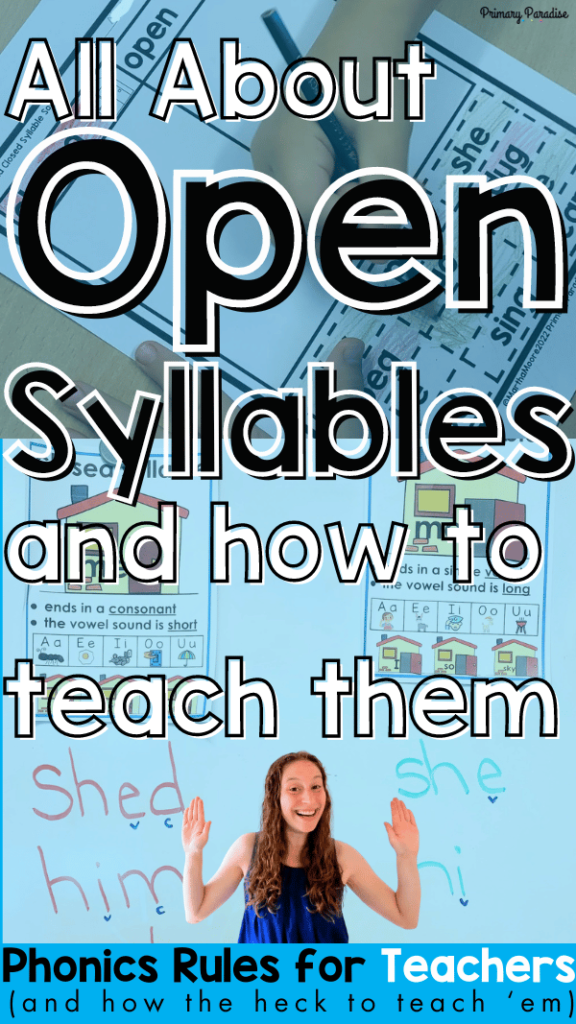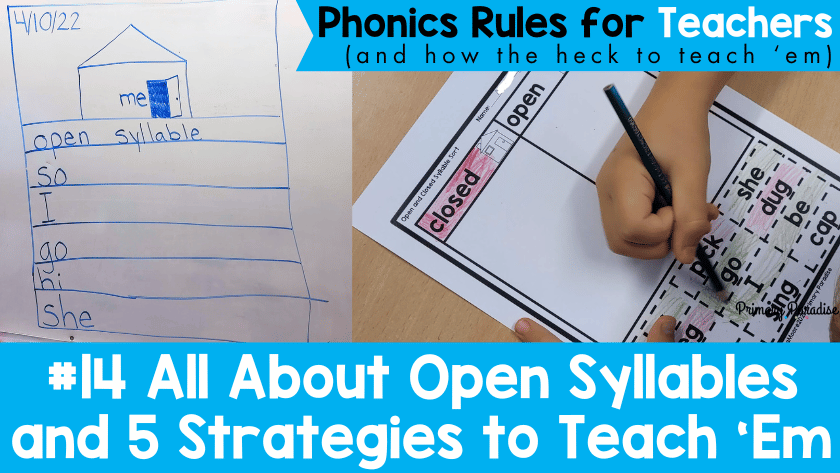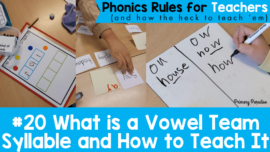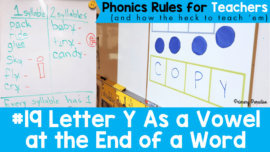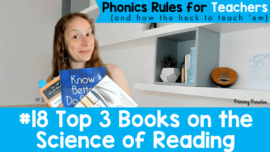Knowing how to teach open syllables is an important phonics skill for teachers. You also need simple, engaging, and effective strategies to practice open syllables with your students. Let’s take a look at the characteristics of an open syllable, where we find them, and how to teach the open syllable to your students.
This is post 14 in my series Phonics Rules for Teachers (and How the Heck to Teach ‘Em). If you’d like to see previous posts, you can click here.
Would you rather listen or watch? Find a podcast version of this blog post or watch the video below.
Background knowledge before teaching open syllables
Before teaching open syllables, it’s important that your students have a firm understanding of some other foundational concepts. The order in which we teach phonics concepts is important to build a solid understanding.
First, they should understand the difference between consonants and vowels because you’re going to discuss how these two types of sounds change based on the letters in a word. The also should understand the concepts of short vowels and closed syllables. Finally, students should have already had a brief introduction to long vowel sounds.
Once students have an understanding of these concepts and have had a change to practice them, they’re ready to learn about the 2nd syllable type- open syllables (find a quick overview of all syllable types here).
What is an open syllable?
An open syllable ends in a single vowel letter and usually has a long vowel sound. We say usually because sometimes open syllables represent another vowel sound (example: do). They can also have a schwa sound (ie, the sound at the end of my name: Martha).
Open and closed syllables make up about 75% of written syllables in English, so if students know just these two syllable types, they can read a lot of words! This, plus the facts that both of these syllable types follow a clear pattern and many one syllable words are either closed or open syllables, means it makes sense to teach these types of syllables first.
As students progress in their phonics understanding, they will be able to read multisyllabic words. And, many multisyllabic words are written with open and closed syllables.
It’s important to note that syllables that end with a single y are open syllable because in these words, y is representing the vowel sound. However, unless students have already learned about y spelling vowel sounds, I wouldn’t focus on these open syllable words just yet.
Examples of open syllable words
- 1 syllable: I, me, no, go, so, my, fly, we, she
- 2 syllable: redo (re/do), baby (ba/by), tiny (ti/ny), hazy (ha/zy)
- 3 syllable: potato (po/ta/to), banana (ba/na/na)
5 Strategies to Teach Open Syllables in Your Classroom
Now that we know what open syllable words are, here are 5 strategies to teach open syllables.
1. Compare with Closed Syllables
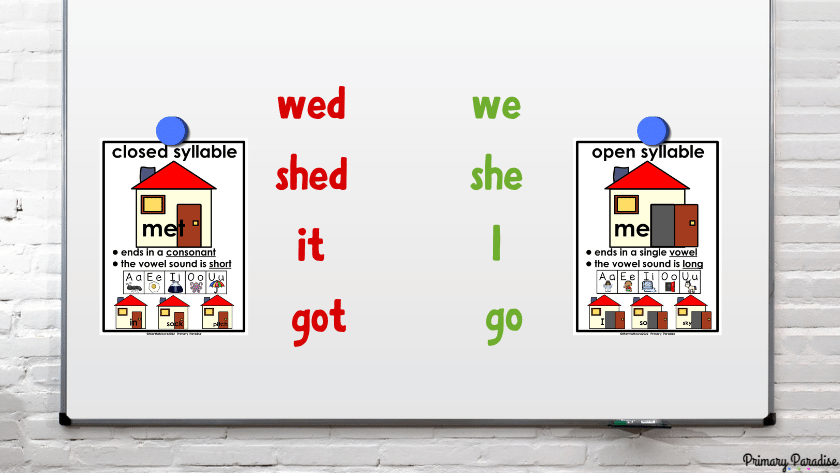
One of the reasons that I love teaching open syllables after closed syllables is that is allows you to compare the two syllable types. Closed syllables also have a single vowel letter, but they end with a consonant. As I’ve previously shared, most English words end with a closed mouth. Since short vowels leave the mouth open, we use the consonant in a closed syllable to close the mouth.
In contrast, open syllables end with a single vowel letter. This is because (with the exception of the schwa sound), long vowel and diphthong vowel sounds end with a closing of the mouth.
So, begin by showing students some closed syllable words that can easily be turned into open syllable words. Ask them to read the words, and then write the same words without the final consonant. Ask students if they recognize any of the words. Read them together, and then have them focus on the change in vowel sound.
Explain to students that these new words are open syllables. Open syllables end in a single vowel, and the vowel usually makes a long vowel sound. Tell them that it’s “open” because the vowel is not closed in by a consonant. Another great illustration of this is to write the words on cards on a door frame, and put the ending consonant on the door. When the door is open, the words are open syllable words. When the door is closed, they’re closed syllable words.
Use can use the hand motion of a door opening to help students remember this concept just as we used the hand motion of a closed door to help us remember closed syllables.
2. Word sorts with closed and open syllables
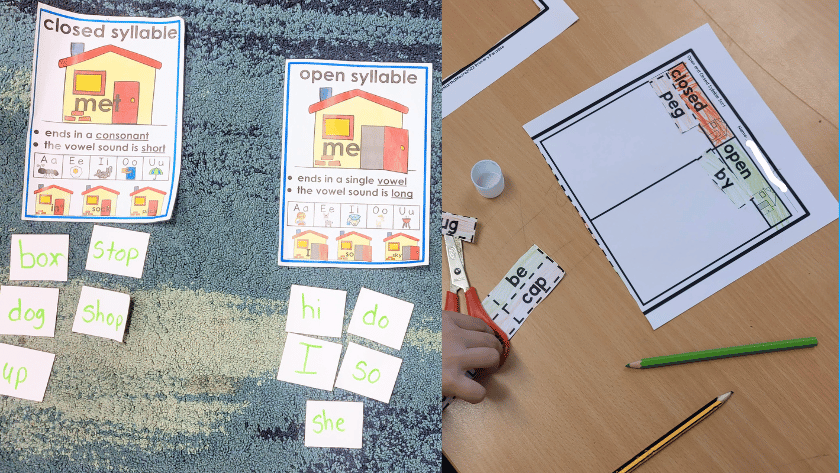
Once students have been introduced to the idea of open syllables, take time to practice working with these new words. A great way to do this is to complete word sorts with closed and open syllables. You should practice this together as a whole class first. Be sure to model looking for the spelling patterns of words ending in a vowel and consonant and words ending in a single vowel.
After you’ve practice this together, you can have students practice in small groups and independently as well. Be sure that students are both looking at the spelling patterns and checking by reading the words out loud.
3. Be sure not to over generalize
While most open syllable words have a long vowel sound, some have another vowel sound such as do and to. Some also have a schwa sound such as banana. After students have had some practice with open syllables with a long vowel sound, show them some words that fall into these two categories. While it’s important to teach them phonics rules, it’s also important for students not to over generalize. This is why we use words like “usually” and “most of the time”. Words like to, do, and banana aren’t breaking the rule”. They simply fall into the “sometimes” category of the open syllable rules.
4. Practice writing and reading
Students learn best when they’re able to apply their new knowledge in context, so be sure to give them the opportunity to practice, practice practice both reading and writing open syllable words. Here are some of my favorite ways to practice new phonics patterns in context. These activities can work with any spelling pattern, so they’re great activities to keep in your back pocket.
- Magic Word Change Game– All you need are whiteboards and markers. Start with a word and change/add/remove one letter at a time to make new words. This is great because you can practice open and closed syllables together. (Read a more in-depth description here.) Example string of words for students to practice: be-bet-met-me-she-shed-bed, be
- Targeted Journals– Ask students to share open syllable words, and write them up in a list. Then, ask students to choose 1 word and use it in a sentence in their journal and illustrate it. Afterwards, have them share out their sentences.
- Snowball Fight– Every student writes a single word on 3 pieces of paper. Here, we were learning the long o ow spelling, so they had to pick long o ow words. Then, they crumple up their paper to make snowballs. In the count of 3, everyone throws their snowballs. Next, everyone gathers three snowballs. They open them up, read the words, and then write them on the recording sheet. You can even have them write a sentence instead of just the word. They crumple up those snowballs again and play another round.
- Musical Sentences- Place a decodable sentence at each student’s spot with the sentences facing down. Each sentence will have a word or words that contain an open syllable. Students walk around the tables with a white board and marker. Play music and when the music stops, they flip over the sentence, read it out loud, and then write down the word/s that have the spelling pattern we’re focusing on. At the end of the activity, have students share some of the words they’ve written.
- Read Decodable Texts– Have students practice reading decodable texts that include open syllable words. The texts should contain only the spelling patterns/letter sounds they’ve already learned. Of course, it’s not always easy to find texts that are 100% decodable, but use texts as close to 100% decodable as you can.
5. Catch open syllables
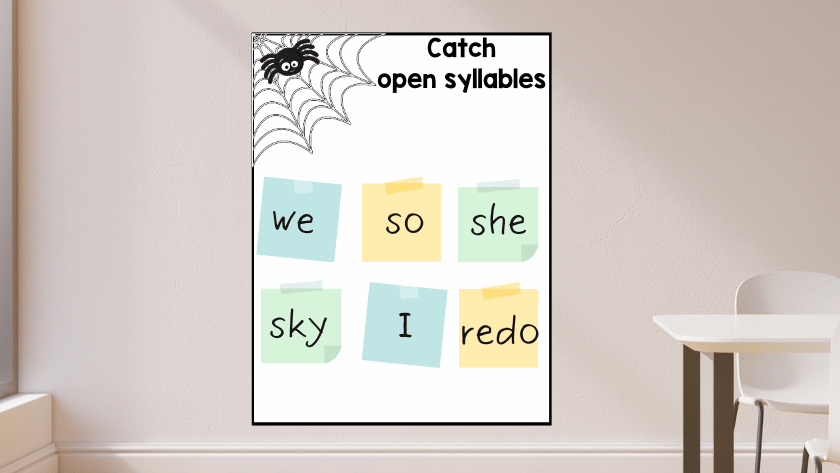
Lastly, you can catch open syllables. After introducing open syllables, create a blank chart in your classroom that students can easily access. If you want to get fancy, you could create a web with a spider called “open”, but a plain old chart paper works perfectly as well. When they discover an open syllable word in a book or story, or even in environmental print, students can write the word on the chart. This activity encourages them to really be aware of the spelling patterns around them, and you can continue to complete a chart for each new syllable type you learn.
Understanding open syllables is a great first step to understanding long vowels and the different ways vowels in English are spelled.
